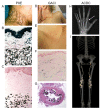Therapeutics Development for Pseudoxanthoma Elasticum and Related Ectopic Mineralization Disorders: Update 2020
- PMID: 33396306
- PMCID: PMC7795895
- DOI: 10.3390/jcm10010114
Therapeutics Development for Pseudoxanthoma Elasticum and Related Ectopic Mineralization Disorders: Update 2020
Abstract
Pseudoxanthoma elasticum (PXE), the prototype of heritable ectopic mineralization disorders, manifests with deposition of calcium hydroxyapatite crystals in the skin, eyes and arterial blood vessels. This autosomal recessive disorder, due to mutations in ABCC6, is usually diagnosed around the second decade of life. In the spectrum of heritable ectopic mineralization disorders are also generalized arterial calcification of infancy (GACI), with extremely severe arterial calcification diagnosed by prenatal ultrasound or perinatally, and arterial calcification due to CD73 deficiency (ACDC) manifesting with arterial and juxta-articular mineralization in the elderly; the latter disorders are caused by mutations in ENPP1 and NT5E, respectively. The unifying pathomechanistic feature in these three conditions is reduced plasma levels of inorganic pyrophosphate (PPi), a powerful endogenous inhibitor of ectopic mineralization. Several on-going attempts to develop treatments for these conditions, either with the goal to normalize PPi plasma levels or by means of preventing calcium hydroxyapatite deposition independent of PPi, are in advanced preclinical levels or in early clinical trials. This overview summarizes the prospects of treatment development for ectopic mineralization disorders, with PXE, GACI and ACDC as the target diseases, from the 2020 vantage point.
Keywords: arterial calcification due to CD73 deficiency; ectopic mineralization disorders; generalized arterial calcification of infancy; pseudoxanthoma elasticum; therapy development.
Conflict of interest statement
The authors declare no conflict of interest.
Figures


References
-
- Markello T.C., Pak L.K., St Hilaire C., Dorward H., Ziegler S.G., Chen M.Y., Chaganti K., Nussbaum R.L., Boehm M., Gahl W.A. Vascular pathology of medial arterial calcifications in NT5E deficiency: Implications for the role of adenosine in pseudoxanthoma elasticum. Mol. Genet. Metab. 2011;103:44–50. doi: 10.1016/j.ymgme.2011.01.018. - DOI - PMC - PubMed
-
- Li Q., Schumacher W., Siegel D., Jablonski D., Uitto J. Cutaneous features of pseudoxanthoma elasticum in a patient with generalized arterial calcification of infancy due to a homozygous missense mutation in the ENPP1 gene. Br. J. Dermatol. 2012;166:1107–1111. doi: 10.1111/j.1365-2133.2012.10811.x. - DOI - PMC - PubMed
Publication types
Grants and funding
LinkOut - more resources
Full Text Sources
Research Materials
Miscellaneous

